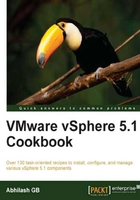
Enabling Stateless Caching
ESXi servers deployed using AutoDeploy require the Auto Deploy server to be available and reachable every time the host reboots. Prior to vSphere 5.1, if the network boot fails, the server did not have a source to continue the boot process. Now with vSphere 5.1, you can enable Stateless Caching that will add a level resiliency in case the network boot (PXE boot) fails. The Stateless Caching mode is enabled by editing the Host Profile associated to the ESX server.
How to do it…
The following procedure will help you enable Stateless Caching:
- Select the Host Profile and navigate to Actions | Edit Host Profile.

- At the Edit Host Profile wizard, click on Next to go to the Edit Host Profile page of the wizard.
- Expand Advanced Configuration Settings and then check the System Image Cache Configuration checkbox.

- On the right-pane, use the System Image Cache Profile Settings drop-down menu to select Enable stateless caching on the host from the list.

- Once selected, it will show the arguments for the first local disk.

Note
Note that usually there is no need to change the argument, because it auto detects the first local disk available.
- If intended you could also choose to overwrite the VMFS volumes on the selected disk.
- Click on Finish to close the Edit Host Profile wizard.
- Change the boot order in the BIOS of the ESXi machine in a way that it would always attempt a network boot first and then fall back to hard drive if network boot fails.

- Reboot the ESX Server.
How it works…
Once you have enabled Stateless Caching on the associated Host Profile and configured the BIOS to always do a network boot first and then during the next reboot of the ESX machine, it performs a network boot and loads the ESXi Image from the Auto Deploy server. The server finishes booting and applies (remediation) the Host Profile. Remediation will dump the ESXi Image running in memory to the first disk (the local disk by default) selected during the Stateless configuration.
Subsequent to this, if an attempt to network-boot the server fails, it will load the image that was cached to the local disk during the previous successful network boot.